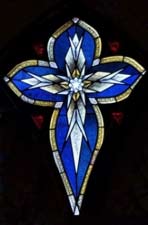|
Buildings and Grounds Ministry

Restoration | Rectory | Grounds | Stained Glass Windows

Lit By God’s Light:
The Windows of Trinity Churche
Stewardship
 We are blessed by the generosity of our Trinity forbearers, who left us this beautiful spiritual home. We are its stewards. We enjoy it, care for it, and periodically restore it. The stained-glass windows require attention to maintain their beauty and integrity, and sometimes, they need restoration, or even replacement. A master plan keeps us mindful of our responsibility to ensure that these windows will continue to enchant future generations. We are blessed by the generosity of our Trinity forbearers, who left us this beautiful spiritual home. We are its stewards. We enjoy it, care for it, and periodically restore it. The stained-glass windows require attention to maintain their beauty and integrity, and sometimes, they need restoration, or even replacement. A master plan keeps us mindful of our responsibility to ensure that these windows will continue to enchant future generations.
It has taken more than 130 years to acquire these beautiful windows—the first in 1881 and the most recent in October 2013. Each window is in loving memory of Trinity parishioners—a sister for a brother, a daughter for a father, a mother for a son, a wife for a husband, and the parish for a Deacon, etc. They are testimony to man’s deep love for another, an everlasting expression put in God’s house, for all to see. You are invited to see their mystical beauty on these pages.
Of the 16 stained-glass windows, thirteen can be seen from inside the church. The nave is beautifully embellished with 10 lancet windows, made by five different studios from Connecticut, Massachusetts, New York, Pennsylvania and Vermont.
A Bit of Stained Glass History
Glass is an ancient invention. The first use of colored glass in a religious setting dates from the 7th century. The Middle Ages saw glass used to illustrate stories from the Bible, culminating in the exquisite windows of Chartres and Canterbury Cathedrals. During the 18th century, many stained glass windows were destroyed by zealous reformers, condemning them as idolatrous. The late 19th century saw a renaissance of the craft. Fine examples of American stained glass may be found particularly in Episcopal and Methodist churches.
Structural innovations in cathedral architecture in Europe, allowed for the expansion of narrow, vertical Romanesque windows into Gothic walls of colored sunlight. The effect was not as much to illuminate the interior as to create an atmosphere of physical and spiritual beauty: “stained glass prevents much of the natural light from entering, providing instead colored and changing light in the windows themselves and flickering light over the stone interior.” The windows were used to teach the stories of the Bible to illiterate citizens, evidenced by one wall in Canterbury Cathedral being known as the “Poor Man’s Bible.” The message of the Gospel would be read, visually reinforced by the light, with such beauty, that believers could mystically connect with the depictions in the windows. As a teaching tool, the windows brought delight and connection to God. Symbolism in design elements emerged, and standard thematic treatments grew. Colors, numbers, letters, geometry, flowers and trees all played a part in the visual message. Symbolic theological or cosmological beliefs determined location—whether to be placed on a wall facing north, south, east or west.

“A speaking picture, with this end,
to teach and delight.”
Sir Philip Sidney (1554-1586)

The Making of Stained Glass
Stained glass requires the artistic skill to conceive a design, and the engineering skills to assemble the piece to withstand the test of time, and the environment. Techniques vary - painting or layering. Hand painting involves each piece being painted, then kiln-fired (sometimes several times) to fuse the imagery permanently into the glass; or laminating clear glass; or painting with glass pigments. Layering, or glass plating, gives dimension (as seen in the Alden & Ellen Young Window). More than one layer of stained glass is soldered on top of the other using copper foil. The glass itself comes from different eras and different processes—opalescent, also known as American glass(created by Tiffany), mixed clear and molten glass, semi-translucent glass, adding mineral salts to clear glass to make colored glass, mouth-blown colored glass; they all create different effects. Glass can resemble gems, adding to the overall brilliance of the windows. In fact, Louis Comfort Tiffany’s inspiration was watching his parents create art with jewelry.
Photography: Peter C. Otis, Rev. Sharon Gracen, Jerry Dougherty
References: Institute of Sacred Architecture, Trinity Church Archives, Dolores Hutch Research Paper
|